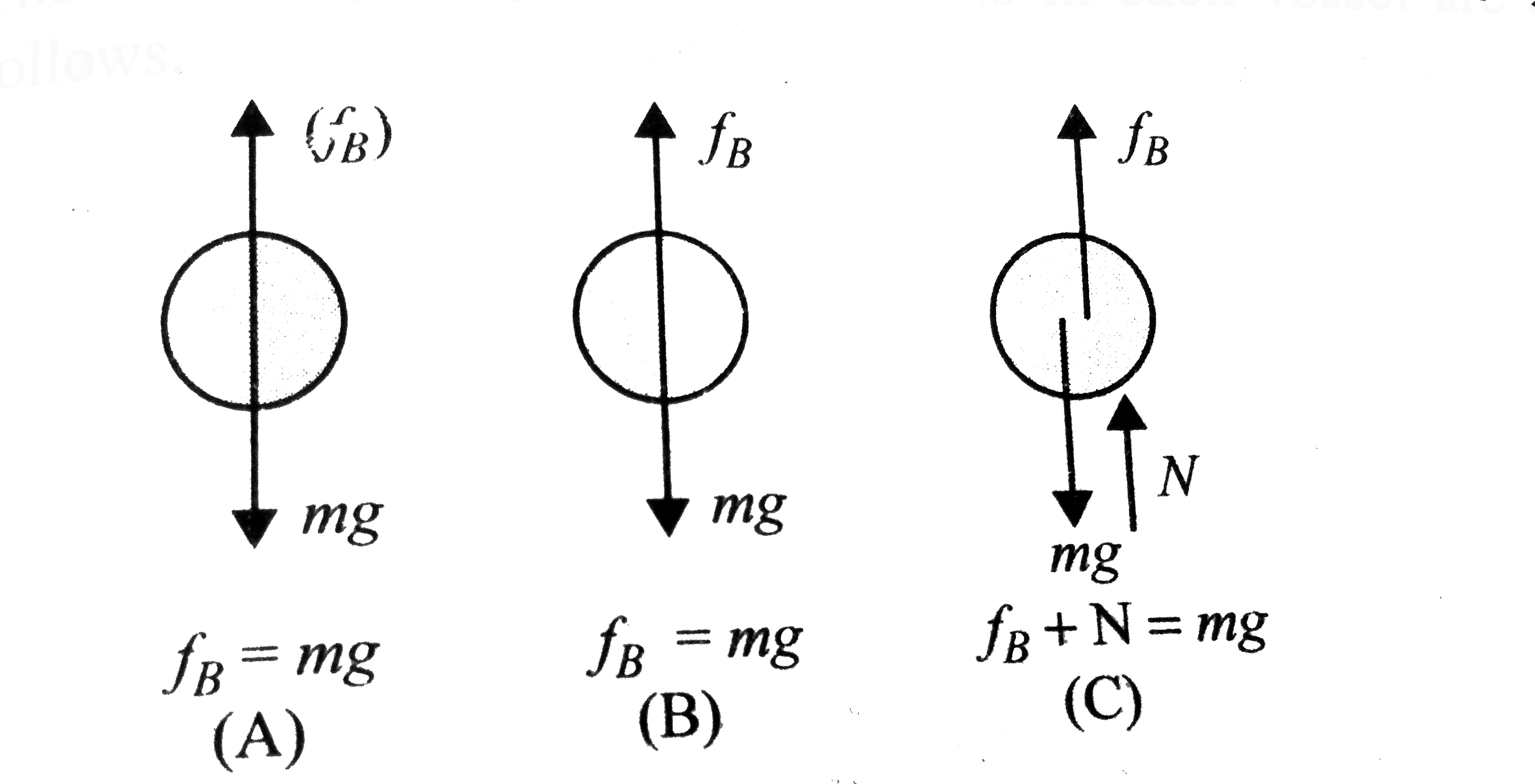Three identical vessels A,B and C contain same quantity of liquid. In each vessel balls of different densities but same masses are placed. In vessel A, the ball is partly submerged, in vessel B, the ball is completely submerged but floating and in vessel C, the ball has sunk to the base. If FA,FB and FC are the total forces acting on the base of vessels A,B and C, respectively, then

FA=FB=FC
FA<FB<FC
FA=FB<FC
FA<FB<FC
The correct Answer is:A
W= weight of liquid
fB= buoyant force on the ball
mg= weight of the ball
N= normal reaction between the ball and the surface
The free body diagrams of the balloon each vessel are as follows

At base reaction force of buoyant force will act in downward direction.
The force acting at the base of each tank are
FA=W+fB=W+mg
FB=W+fB=W+mg
FC=W+FB+N=W+mg
Thus FA=FB=FC
Topper's Solved these Questions
- FLUID MECHANICSBOOK - CENGAGE PHYSICSCHAPTER - FLUID MECHANICSEXERCISE - Multipe Correct
15 Videos
- FLUID MECHANICSBOOK - CENGAGE PHYSICSCHAPTER - FLUID MECHANICSEXERCISE - Assertion-Reasoning
8 Videos
- FLUID MECHANICSBOOK - CENGAGE PHYSICSCHAPTER - FLUID MECHANICSEXERCISE - Subjective
25 Videos
- DIMENSIONS & MEASUREMENTBOOK - CENGAGE PHYSICSCHAPTER - DIMENSIONS & MEASUREMENTEXERCISE - Integer
2 Videos
- GRAVITATIONBOOK - CENGAGE PHYSICSCHAPTER - GRAVITATIONEXERCISE - INTEGER_TYPE
1 Videos
Similar Questions
Two vessels A and B have same base area. Equal volumes of a liquid are poured in the two vessel to difference heights hA and hB(>hA. In which vessel, the force on the base of vessel will be more?
View SolutionA sphere of radius 6 cm is dropped in a right circular cylindrical vessel, partly filled with water. If the sphere is completely submerged, the water level in the vessel rises by 2 cm. What is the diameter of the vessel ? (in cm.)
View Solution
Knowledge Check
Three vessels A,B,and C of different shapes contain a water upto the same height as shown in the figure .PA,PB ,and PC be the pressure exerted by the water at the bottom of the vessels A ,B and C respectively . Then
 APA>PB>PCBPB>PC>PACPC>PB>PADPA=PB=PC
APA>PB>PCBPB>PC>PACPC>PB>PADPA=PB=PCThree vessels A, B and C of different shapes contain water upto the same height in the figure. PA,PBandPC be the pressure exerted by the water at the bottom of the vessels A, B and C respectively. Then
 APA>PB>PCBPB>PC>PACPC>PB>PADPA=PB=PC
APA>PB>PCBPB>PC>PACPC>PB>PADPA=PB=PCThere are two identical vessels containing same quantity of an ideal gas at same pressure vessel A is placed in a train moving with constant speed and the vessel B is placed on the platform in the frame of an observer standing on the platform select the correct statement
ATemperature of gas in both vessel is same where as kinetic energy of gas in the vessel is differentBkinetic energy of gas in both vessels is same but temperature are differentCboth kinetic energy and temperature are same.Dboth kinetic energy and temperature are different
Two identical vessels contain two different ideal gases at the same temperature. If the average speed of gas molecules in the first vessel is euqal to the most probable speed of molecules in the second vessel, then the ratio of the mass of gas molecules in the first vessel to that in the second vessel is
View SolutionTwo vessels of the same volume contain the same gas at same temperature. If the pressure in the vessels is in the ratio of 1 : 2, then
View SolutionThe three vessels shown in figure have same base area. Equal volumes of a liquid are poured in the thre vessels. The force on the base will be

View SolutionThree identical vessels A ,B an C are filled with water , mercury and kerosene respectively up to a equal height. The theree vessels are provided with identical taps at the bottom t= of the vessels .If the three taps are opened simultaneously ,then which vessel is emptied first ?
View SolutionTwo vessels A and B of different shapes have the same base area and are filled with water up to the same height h (see figure). The force exerted by water on the base is FA for vessel A and FB for vessel B. The respective weights of the water filled in vessels are WA and WB. Then

View Solution
